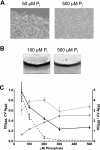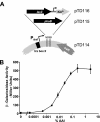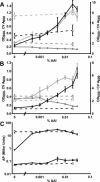Phosphorus limitation enhances biofilm formation of the plant pathogen Agrobacterium tumefaciens through the PhoR-PhoB regulatory system
- PMID: 15231781
- PMCID: PMC438617
- DOI: 10.1128/JB.186.14.4492-4501.2004
Phosphorus limitation enhances biofilm formation of the plant pathogen Agrobacterium tumefaciens through the PhoR-PhoB regulatory system
Erratum in
-
Erratum for Danhorn et al., "Phosphorus Limitation Enhances Biofilm Formation of the Plant Pathogen Agrobacterium tumefaciens through the PhoR-PhoB Regulatory System".J Bacteriol. 2024 Aug 22;206(8):e0023824. doi: 10.1128/jb.00238-24. Epub 2024 Jul 12. J Bacteriol. 2024. PMID: 38995023 Free PMC article. No abstract available.
Abstract
The plant pathogen Agrobacterium tumefaciens forms architecturally complex biofilms on inert surfaces. Adherence of A. tumefaciens C58 was significantly enhanced under phosphate limitation compared to phosphate-replete conditions, despite slower overall growth under low-phosphate conditions. Replacement of Pi with sn-glycerol-3-phosphate and 2-aminoethylphosphonate yielded similar results. The increase in surface interactions under phosphate limitation was observed in both static culture and continuous-culture flow cells. Statistical analysis of confocal micrographs obtained from the flow cell biofilms revealed that phosphate limitation increased both the overall attached biomass and the surface coverage, whereas the maximum thickness of the biofilm was not affected. Functions encoded on the two large plasmids of A. tumefaciens C58, pTiC58 and pAtC58, were not required for the observed phosphate effect. The phosphate concentration at which increased attachment was observed triggered the phosphate limitation response, controlled in many bacteria by the two-component regulatory system PhoR-PhoB. The A. tumefaciens phoB and phoR orthologues could only be disrupted in the presence of plasmid-borne copies of the genes, suggesting that this regulatory system might be essential. Expression of the A. tumefaciens phoB gene from a tightly regulated inducible promoter, however, correlated with the amount of biofilm under both phosphate-limiting and nonlimiting conditions, demonstrating that components of the Pho regulon influence A. tumefaciens surface interactions.
Copyright 2004 American Society for Microbiology
Figures





References
-
- Anderson, G. G., J. J. Palermo, J. D. Schilling, R. Roth, J. Heuser, and S. J. Hultgren. 2003. Intracellular bacterial biofilm-like pods in urinary tract infections. Science 301:105-107. - PubMed
-
- Benning, C., Z.-H. Huang, and D. A. Gage. 1995. Accumulation of a novel glycolipid and a betaine lipid in the cells of Rhodobacter sphaeroides grown under phosphate limitation. Arch. Biochem. Biophys. 317:103-111. - PubMed
Publication types
MeSH terms
Substances
LinkOut - more resources
Full Text Sources
Other Literature Sources
Research Materials
Miscellaneous

